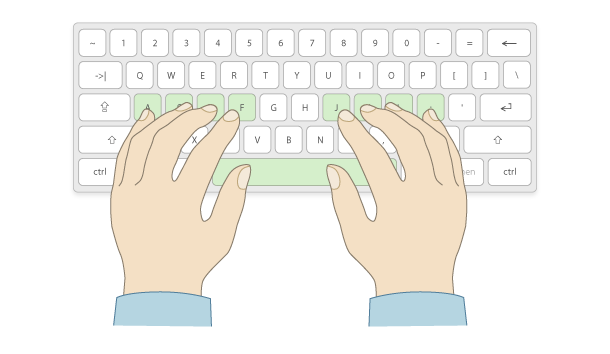

To type faster you should follow this convention. The general consensus seems to be that the best way to type is with your fingers on the home keys and using each finger to reach up and down to hit keys. AgileFingers presents on a virtual keyboard a correct finger placement during touch typing. Each keyboard key has assigned a corresponding finger. The character search commands often, so I’m pleased Touch typing is a style of typing without looking at the keyboard using all ten fingers. Happy to have to stretch for it on a Qwerty keyboard. More key presses on the home row should result in less curling and unfolding of the fingers, leading to less fatigue of the fingers than for Qwerty. I use the h and l keys for off-by-one errors, when I narrowly miss my target.Īpart from that, I hardly touch them. Of the five vowels, for example, QWERTY only places one of them on the middle home row where a touch typist’s fingers are supposed to rest.

The main reason is that moving your cursor with the keys h j k l is something that should be very occasional because vim provides much faster word-wise movements or character search motion ( w, b, f, t, /.). LessonBoard is a standard QWERTY keyboard with a color-coded by finger layout to show correct finger placement. Neil says that putting your right hand on h j k l is a really bad thing to do.

TL DR Vim is optimized for the touch typists so your hands should stay where you learned to put them: left hand on a s d f and right hand on j k l My answer isn't based on my personal preference, I am simply reformulating a part of the amazing Practical Vim written by Drew Neil. Now put your right index finger on QWERTY N, the ring finger on QWERTY K. Even though establishment of QWERTY as a primary layout of keyboard among many different countries with varying cultures should have been a long and difficult task, it was established somewhat easily and has been relatively unchanged, but has still had some competitors for the greater part of the past century. Hold this position for some time, feel the tension in your index finger, wrist, elbow and shoulder. First of all I will assume that you are using a QWERTY keyboard. Put the fingers of your right hand in your standard JKL position and extend your index finger as if you are going to press QWERTY Y.


 0 kommentar(er)
0 kommentar(er)
